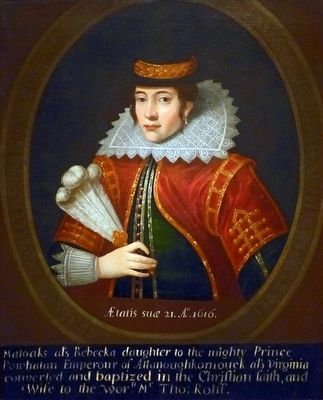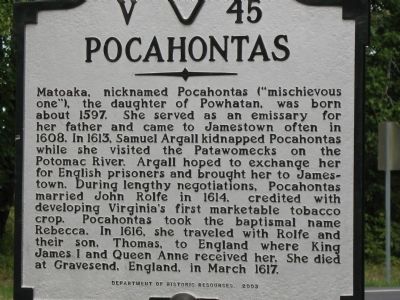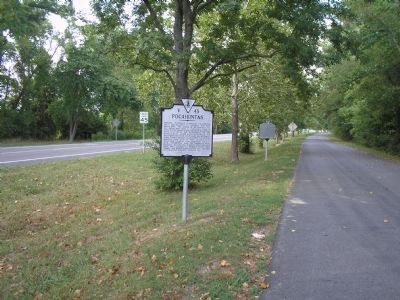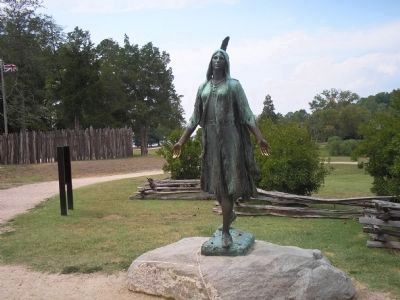Near Williamsburg in James City County, Virginia — The American South (Mid-Atlantic)
Pocahontas
Erected 2003 by Department of Historic Resources. (Marker Number V-45.)
Topics and series. This historical marker is listed in these topic lists: Churches & Religion • Colonial Era • Native Americans • Women. In addition, it is included in the Virginia Department of Historic Resources (DHR) series list. A significant historical month for this entry is March 1617.
Location. 37° 13.805′ N, 76° 46.799′ W. Marker is near Williamsburg, Virginia, in James City County. Marker is on Jamestown Road (Virginia Route 31) near Colonial National Historical Parkway. This marker sits on a road that runs parallel to Jamestown Rd. and can be accessed off of Colonial Pkwy. Touch for map. Marker is in this post office area: Williamsburg VA 23185, United States of America. Touch for directions.
Other nearby markers. At least 8 other markers are within walking distance of this marker. Jamestown Road (a few steps from this marker); Samuel H. Yonge, Civil Engineer (1843-1935) (a few steps from this marker); First Germans at Jamestown (within shouting distance of this marker); First Africans In Jamestown (within shouting distance of this marker); First Africans in English America (within shouting distance of this marker); Jamestown (within shouting distance of this marker); First Poles Arrive (about 300 feet away, measured in a direct line); Angelo (fl. 1619-1625) (about 700 feet away). Touch for a list and map of all markers in Williamsburg.
More about this marker. This marker sits with four others V-44, WT-1, WT-2, W-38.
Related markers. Click here for a list of markers that are related to this marker. Other markers concerning the kidnapping of Pocahontas.

Photographed By Allen C. Browne, February 16, 2015
4. Pocahontas, age 21, 1616
This portrait of Pocahontas (Matoaks) after a 1616 engraving by Simon van de Passe hangs in the National Portrait Gallery in Washington DC.
Ætatis suæ 21. Ao. 1616.
Matoaks als Rebecka daughter to the mighty Prince Powhatan Emperour of Attanoughkomouck als Virginia converted and baptized in the Chriƒtian faith, and Wife to the worʰ. Mr Tho: Rolff.
“Pocahontas, the Indian princess who allegedly saved the life of English colonist John Smith, survives and flourishes as an example of an early American heroine. While Smith may have embellished the story of his rescue, the importance of Pocahontas to relations between colonists and Native Americans is undisputed. Following her conversion to Christianity and marriage to Englishman John Rolfe, Pocahontas journeyed to England with her family to demonstrate the ability of new settlers and native tribes to coexist in the Virginia colony. While in England, Pocahontas sat for her portrait, which was later engraved. That print served as the basis for this later portrait. The painter included an inscription beneath the likeness, copied from the engraving, but through an error in transcription it misidentifies her husband as Thomas, the name given to their son.” — National Portrait Gallery
Ætatis suæ 21. Ao. 1616.
Matoaks als Rebecka daughter to the mighty Prince Powhatan Emperour of Attanoughkomouck als Virginia converted and baptized in the Chriƒtian faith, and Wife to the worʰ. Mr Tho: Rolff.
“Pocahontas, the Indian princess who allegedly saved the life of English colonist John Smith, survives and flourishes as an example of an early American heroine. While Smith may have embellished the story of his rescue, the importance of Pocahontas to relations between colonists and Native Americans is undisputed. Following her conversion to Christianity and marriage to Englishman John Rolfe, Pocahontas journeyed to England with her family to demonstrate the ability of new settlers and native tribes to coexist in the Virginia colony. While in England, Pocahontas sat for her portrait, which was later engraved. That print served as the basis for this later portrait. The painter included an inscription beneath the likeness, copied from the engraving, but through an error in transcription it misidentifies her husband as Thomas, the name given to their son.” — National Portrait Gallery
Credits. This page was last revised on April 5, 2022. It was originally submitted on September 11, 2007, by Laura Troy of Burke, Virginia. This page has been viewed 1,997 times since then and 39 times this year. Last updated on April 5, 2022, by Carl Gordon Moore Jr. of North East, Maryland. Photos: 1. submitted on September 11, 2007, by Laura Troy of Burke, Virginia. 2, 3. submitted on August 14, 2008, by Bill Coughlin of Woodland Park, New Jersey. 4. submitted on October 26, 2015, by Allen C. Browne of Silver Spring, Maryland. • Bernard Fisher was the editor who published this page.


